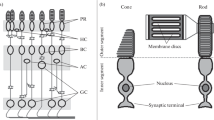Abstract
To analyze the wavelength dependency of magnetic compass orientation, European robins were tested during spring migration under light of various wavelengths. Under 565-nm green light (control) the birds showed excellent orientation in their migratory direction; a 120° deflection of magnetic North resulted in a corresponding shift in the birds' directional tendencies, indicating the use of the magnetic compass. Under 443-nm blue light, the robins were likewise well oriented. Under 590-nm yellow, however, oriented behavior was no longer observed, although the activity was at the same level as under blue and green light. The spectral range where magnetic orientation is possible thus differs from the range of vision, the former showing parallels to that of rhodopsin absorption. The interpretation of the abrupt change in behavior observed between 565 green to 590 yellow is unclear. There is no simple relationship between magnetoreception and the known color receptors of birds.
Similar content being viewed by others
Author information
Authors and Affiliations
Additional information
Accepted: 17 December 1998
Rights and permissions
About this article
Cite this article
Wiltschko, W., Wiltschko, R. The effect of yellow and blue light on magnetic compass orientation in European robins, Erithacus rubecula. J Comp Physiol A 184, 295–299 (1999). https://doi.org/10.1007/s003590050327
Issue Date:
DOI: https://doi.org/10.1007/s003590050327




